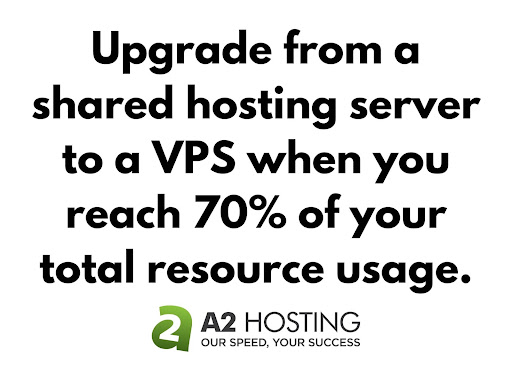
When you first started out building your business from the ground up, you probably didn’t need to think about upgrading from a shared hosting package to a Virtual Private Server (VPS). But as time went on and you found your website receiving more traffic and your posts receiving more likes, you may have started to feel like your hosting package couldn’t keep up with the demand of your website. If this is you, you’re in luck. In this article, we’ll outline when it’s time to upgrade from shared hosting to a VPS plan making it easier to understand how to optimize your hosting experience.
First of all, what is the difference between a shared hosting server and a VPS?
A shared hosting server is a server where resources are shared among many individuals. In a shared hosting environment, you share an IP address (unless you want to request a dedicated IP address for $5.99/monthly), and resources like RAM, disk space, and memory are split amongst all users. When one user is using up all of the bandwidth, it can affect other users on the server (but we’ll throttle users exceeding minimum usages so others on the server won’t be affected).
A shared hosting server is like staying in a hostel. You share a bathroom, kitchen, and all resources with others in the building.
On the other hand, a VPS (Virtual Private Server) is a server where resources are allocated virtually through what’s called a hypervisor to create virtual machines for every user on the server. You share the physical resources with others, but your site gets dedicated resources in its own virtual allocation, cut off from the other accounts on the server.
To extend the hotel metaphor, a VPS is like renting a bed and breakfast for a weekend. You have your own room, but everyone else in the building shares the house.
So, now that we know what the differences between shared and VPS servers are, let’s discuss when it’s time to upgrade from a shared hosting plan to a VPS.
When Is It Time to Upgrade from a Shared Hosting Server to a Virtual Private Server (VPS)?
This is a question we get a lot, so we want to give you the right answers. We always recommend the 70/30 rule. What this means is that you want to upgrade from a shared hosting server to a VPS when you’re reached 70% of your total resource usage for all of your resources combined (RAM, disk space, CPU, and bandwidth).
If you upgrade when you’re at 70% resource usage, you have time to move into another plan without noticing any performance issues on your website. When you wait, it only hurts your business.
NOTE: We’ll email you warning you of resource uses once you get past 50% usage. We won’t suspend your account without any warning.
What are the advantages of shared hosting?
- It’s the least expensive option available for web hosting. These servers cost between $5.99-$29.99 monthly.
- You can seamlessly upgrade between plans at any time.
- Some plans like the Turbo Boost and Turbo Max are faster than certain VPS plans like the Lift 4 and Lift 8.
Shared hosting plans are best for small-budget website owners or small businesses with little traffic. You can always upgrade to a higher plan at any time so it’s best to start small first.
What are the disadvantages of shared hosting?
- Load times can be slower because you’re sharing a server.
- When your site receives higher levels of traffic, you might notice a dip in performance.
- You don’t know who you’re sharing a server with.
- There can be a lack of customizations.
What are the advantages of VPS hosting?
- You’ll have more dedicated resources at your disposal to support growing traffic levels and maintain your speed.
- Higher priority 24/7/365 support.
- More server control and the ability to customize to your liking.
- An affordable option for those who want a dedicated server but don’t want to pay for dedicated server prices.
What are the disadvantages of VPS hosting?
- Is typically more expensive than a shared hosting plan.
- Can be slower than certain turbo shared hosting plans like the Turbo Boost and Turbo Max.
- Can require a higher level of technical expertise to get off the ground.
The plan you should choose depends on your current needs. You can always upgrade later, but you don’t want to pick a plan above the resources that your website truly needs unless you’re expecting rapid growth. And if you notice you’re not getting the performance you’re used to, it’s probably time to contact our sales team today. Remember the 70/30 rule when you’re considering an upgrade.
Related Resources:
https://www.a2hosting.com/blog/when-is-it-time-to-upgrade-from-a-shared-hosting-server-to-a-virtual-private-server-vps/






